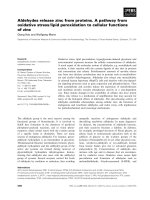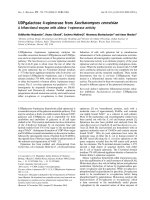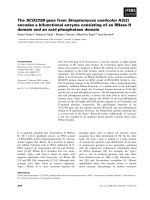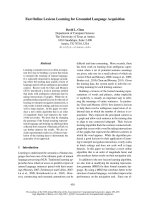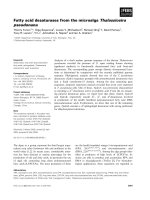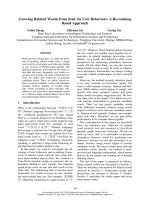Báo cáo khoa học: "Building Emotion Lexicon from Weblog Corpora" potx
Bạn đang xem bản rút gọn của tài liệu. Xem và tải ngay bản đầy đủ của tài liệu tại đây (208.7 KB, 4 trang )
Proceedings of the ACL 2007 Demo and Poster Sessions, pages 133–136,
Prague, June 2007.
c
2007 Association for Computational Linguistics
Building Emotion Lexicon from Weblog Corpora
Changhua Yang Kevin Hsin-Yih Lin Hsin-Hsi Chen
Department of Computer Science and Information Engineering
National Taiwan University
#1 Roosevelt Rd. Sec. 4, Taipei, Taiwan 106
{d91013, f93141, hhchen}@csie.ntu.edu.tw
Abstract
An emotion lexicon is an indispensable re-
source for emotion analysis. This paper
aims to mine the relationships between
words and emotions using weblog corpora.
A collocation model is proposed to learn
emotion lexicons from weblog articles.
Emotion classification at sentence level is
experimented by using the mined lexicons
to demonstrate their usefulness.
1 Introduction
Weblog (blog) is one of the most widely used cy-
bermedia in our internet lives that captures and
shares moments of our day-to-day experiences,
anytime and anywhere. Blogs are web sites that
timestamp posts from an individual or a group of
people, called bloggers. Bloggers may not follow
formal writing styles to express emotional states.
In some cases, they must post in pure text, so they
add printable characters, such as “:-)” (happy) and
“:-(“ (sad), to express their feelings. In other cases,
they type sentences with an internet messenger-
style interface, where they can attach a special set
of graphic icons, or emoticons. Different kinds of
emoticons are introduced into text expressions to
convey bloggers’ emotions.
Since thousands of blog articles are created eve-
ryday, emotional expressions can be collected to
form a large-scale corpus which guides us to build
vocabularies that are more emotionally expressive.
Our approach can create an emotion lexicon free of
laborious efforts of the experts who must be famil-
iar with both linguistic and psychological knowl-
edge.
2 Related Works
Some previous works considered emoticons from
weblogs as categories for text classification.
Mishne (2005), and Yang and Chen (2006) used
emoticons as tags to train SVM (Cortes and Vap-
nik, 1995) classifiers at document or sentence level.
In their studies, emoticons were taken as moods or
emotion tags, and textual keywords were taken as
features. Wu et al. (2006) proposed a sentence-
level emotion recognition method using dialogs as
their corpus. “Happy, “Unhappy”, or “Neutral”
was assigned to each sentence as its emotion cate-
gory. Yang et al. (2006) adopted Thayer’s model
(1989) to classify music emotions. Each music
segment can be classified into four classes of
moods. In sentiment analysis research, Read (2005)
used emoticons in newsgroup articles to extract
instances relevant for training polarity classifiers.
3 Training and Testing Blog Corpora
We select Yahoo! Kimo Blog
1
posts as our source
of emotional expressions. Yahoo! Kimo Blog
service has 40 emoticons which are shown in Table
1. When an editing article, a blogger can insert an
emoticon by either choosing it or typing in the
corresponding codes. However, not all articles
contain emoticons. That is, users can decide
whether to insert emoticons into articles/sentences
or not. In this paper, we treat these icons as
emotion categories and taggings on the
corresponding text expressions.
The dataset we adopt consists of 5,422,420 blog
articles published at Yahoo! Kimo Blog from
January to July, 2006, spanning a period of 212
days. In total, 336,161 bloggers’ articles were col-
lected. Each blogger posts 16 articles on average.
We used the articles from January to June as the
training set and the articles in July as the testing set.
Table 2 shows the statistics of each set. On aver-
age, 14.10% of the articles contain emotion-tagged
expressions. The average length of articles with
tagged emotions, i.e., 272.58 characters, is shorter
1
133
than that of articles without tagging, i.e., 465.37
characters. It seems that people tend to use emoti-
cons to replace certain amount of text expressions
to make their articles more succinct.
Figure 1 shows the three phases for the con-
struction and evaluation of emotion lexicons. In
phase 1, 1,185,131 sentences containing only one
emoticon are extracted to form a training set to
build emotion lexicons. In phase 2, sentence-level
emotion classifiers are constructed using the mined
lexicons. In phase 3, a testing set consisting of
307,751 sentences is used to evaluate the classifi-
ers.
4 Emotion Lexicon Construction
The blog corpus contains a collection of bloggers’
emotional expressions which can be analyzed to
construct an emotion lexicon consisting of words
that collocate with emoticons. We adopt a variation
of pointwise mutual information (Manning and
Schütze, 1999) to measure the collocation strength
co(e,w) between an emotion e and a word w:
)()(
),(
log),(),o(
wPeP
weP
wecwec ×=
(1)
where P(e,w)=c(e,w)/N, P(e)=c(e)/N, P(w)=c(w)/N,
c(e)
and c(w) are the total occurrences of emoticon
e and word w in a tagged corpus, respectively,
c(e,w) is total co-occurrences of e and w, and N
denotes the total word occurrences.
A word entry of a lexicon may contain several
emotion senses. They are ordered by the colloca-
tion strength co. Figure 2 shows two Chinese ex-
ample words, “ 哈 哈 ” (ha1ha1) and “ 可 惡 ”
(ke3wu4). The former collocates with “laughing”
and “big grin” emoticons with collocation strength
25154.50 and 2667.11, respectively. Similarly, the
latter collocates with “angry” and “phbbbbt”.
When all collocations (i.e., word-emotion pairs)
are listed in a descending order of co, we can
choose top n collocations to build an emotion lexi-
con. In this paper, two lexicons (Lexicons A and B)
are extracted by setting n to 25k and 50k. Lexicon
A contains 4,776 entries with 25,000 sense pairs
and Lexicon B contains 11,243 entries and 50,000
sense pairs.
5 Emotion Classification
Suppose a sentence S to be classified consists of n
emotion words. The emotion of S is derived by a
mapping from a set of n emotion words to m emo-
tion categories as follows:
}, ,{
ˆ
}, ,{
11 m
tionclassifica
n
eeeewewS
∈
→
→
Table 1. Yahoo! Kimo Blog Emoti
c
on Set.
ID
Emoticon
Code
Description
ID
Emoticon
Code
Description
ID
Emoticon
Code
Description
ID
Emoticon
Code
Description
1
:)
happy
11
:O
surprise
21
0:)
angel
31
(:|
yawn
2
:(
sad
12
X-(
angry
22
:-B
nerd
32
=P~
drooling
3
;)
winking
13
:>
smug
23
=;
talk to
the hand
33
:-?
thinking
4
:D
big grin
14
B-)
cool
24
I-)
asleep
34
;))
hee hee
5
;;)
batting
eyelashes
15
:-S
worried
25
8-)
rolling eyes
35
=D>
applause
6
:-/
confused
16
>:)
devil
26
:-&
sick
36
[-o<
praying
7
:x
love struck
17
:((
crying
27
:-$
don't tell
anyone
37
:-<
sigh
8
:”>
blushing
18
:))
laughing
28
[-(
not talking
38
>:P
phbbbbt
9
:p
tongue
19
:|
straight face
29
:o)
clown
39
@};-
rose
10
:*
kiss
20
/:)
raised
eyebrow
30
@-)
hypnotized
40
:@)
pig
Table 2. Statistics of the Weblog Dataset.
Dataset
Article #
Tagged #
Percentage
Tagged Len.
Untagged L.
Training
4,187,737
575,009
13.86%
269.77 chrs.
468.14 chrs.
Testing
1,234,683
182,999
14.92%
281.42 chrs.
455.82 chrs.
Total 5,422,420
764,788
14.10%
272.58 chrs.
465.37 chrs.
Testing Set
Figure 1. Emotion Lexicon Construction and Evaluation.
E
xtra
c
tion
Blog
Articles
F
eatures
Classifiers
Evaluation
Lexicon
Construction
Training Set
Phase 2
Phase 3
Emotion
Lexicon
Phase 1
134
For each emotion word ew
i
, we may find several
emotion senses with the corresponding collocation
strength co by looking up the lexicon. Three alter-
natives are proposed as follows to label a sentence
S with an emotion:
(a) Method 1
(1) Consider all senses of ew
i
as votes. Label S
with the emotion that receives the most votes.
(2) If more than two emotions get the same num-
ber of votes, then label S with the emotion that
has the maximum co.
(b) Method 2
Collect emotion senses from all ew
i
. Label S
with the emotion that has the maximum co.
(c) Method 3
The same as Method 1 except that each ew
i
v-
otes only one sense that has the maximum co.
In past research, the approach used by Yang et
al. (2006) was based on the Thayer’s model (1989),
which divided emotions into 4 categories. In sen-
timent analysis research, such as Read’s study
(2006), a polarity classifier separated instances into
positive and negative classes. In our experiments,
we not only adopt fine-grain classification, but also
coarse-grain classification. We first select 40
emoticons as a category set, and also adopt the
Thayer’s model to divide the emoticons into 4
quadrants of the emotion space. As shown in Fig-
ure 3, the top-right side collects the emotions that
are more positive and energetic and the bottom-left
side is more negative and silent. A polarity classi-
fier uses the right side as positive and the left side
as negative.
6 Evaluation
Table 3 shows the performance under various
combinations of lexicons, emotion categories and
classification methods. “Hit #” stands for the
number of correctly-answered instances. The base-
line represents the precision of predicting the ma-
jority category, such as “happy” or “positive”, as
the answer. The baseline method’s precision in-
creases as the number of emotion classes decreases.
The upper bound recall indicates the upper limit on
the fraction of the 307,751 instances solvable by
the corresponding method and thus reflects the
limitation of the method. The closer a method’s
actual recall is to the upper bound recall, the better
the method. For example, at most 40,855 instances
(14.90%) can be answered using Method 1 in
combination with Lexicon A. But the actual recall
is 4.55% only, meaning that Method 1’s recall is
more than 10% behind its upper bound. Methods
which have a larger set of candidate answers have
higher upper bound recalls, because the probability
that the correct answer is in their set of candidate
answers is greater.
Experiment results show that all methods utiliz-
ing Lexicon A have performance figures lower
than the baseline, so Lexicon A is not useful. In
contrast, Lexicon B, which provides a larger col-
lection of vocabularies and emotion senses, outper-
forms Lexicon A and the baseline. Although
Method 3 has the smallest candidate answer set
and thus has the smallest upper bound recall, it
outperforms the other two methods in most cases.
Method 2 achieves better precisions when using
哈哈
哈哈哈哈
哈哈 (ha1ha1) “hah hah”
Sense 1. (laughing) – co: 25154.50
e.g., 哈哈 我應該要出運了~
“hah hah… I am getting lucky~”
Sense 2. (big grin) – co: 2667.11
e.g., 今天只背了單母音而已~哈哈
“I only memorized vowels today~ haha ”
可惡
可惡可惡
可惡 (ke3wu4) “darn”
Sense 1. (angry) – co: 2797.82
e.g., 駭客在搞什麼 可惡
“What's the hacker doing darn it ”
Sense 2. (phbbbbt) – co: 619.24
e.g., 可惡的外星人…
“Damn those aliens ”
Figure 2. Some Example Words in a Lexicon.
Arousal (energetic)
Valence
(negative) (positive)
(silent)
unassigned:
Figure 3. Emoticons on Thayer’s model.
135
Thayer’s emotion categories. Method 1 treats the
vote to every sense equally. Hence, it loses some
differentiation abilities. Method 1 performs the
best in the first case (Lexicon A, 40 classes).
We can also apply machine learning to the data-
set to train a high-precision classification model.
To experiment with this idea, we adopt LIBSVM
(Fan et al., 2005) as the SVM kernel to deal with
the binary polarity classification problem. The
SVM classifier chooses top k (k = 25, 50, 75, and
100) emotion words as features. Since the SVM
classifier uses a small feature set, there are testing
instances which do not contain any features seen
previously by the SVM classifier. To deal with
this problem, we use the class prediction from
Method 3 for any testing instances without any
features that the SVM classifier can recognize. In
Table 4, the SVM classifier employing 25 features
has the highest precision. On the other hand, the
SVM classifier employing 50 features has the
highest F measure when used in conjunction with
Method 3.
7 Conclusion and Future Work
Our methods for building an emotional lexicon
utilize emoticons from blog articles collaboratively
contributed by bloggers. Since thousands of blog
articles are created everyday, we expect the set of
emotional expressions to keep expanding. In the
experiments, the method of employing each emo-
tion word to vote only one emotion category
achieves the best performance in both fine-grain
and coarse-grain classification.
Acknowledgment
Research of this paper was partially supported by
Excellent Research Projects of National Taiwan
University, under the contract of 95R0062-AE00-
02. We thank Yahoo! Taiwan Inc. for providing
the dataset for researches.
References
Corinna Cortes and V. Vapnik. 1995. Support-Vector
Network. Machine Learning, 20:273–297.
Rong-En Fan, Pai-Hsuen Chen and Chih-Jen Lin. 2005.
Working Set Selection Using Second Order Informa-
tion for Training Support Vector Machines. Journal
of Machine Learning Research, 6:1889–1918.
Gilad Mishne. 2005. Experiments with Mood Classifi-
cation in Blog Posts. Proceedings of 1st Workshop on
Stylistic Analysis of Text for Information Access.
Jonathon Read. 2005. Using Emotions to Reduce De-
pendency in Machine Learning Techniques for Sen-
timent Classification. Proceedings of the ACL Stu-
dent Research Workshop, 43-48.
Robert E. Thayer. 1989. The Biopsychology of Mood
and Arousal, Oxford University Press.
Changhua Yang and Hsin-Hsi Chen. 2006. A Study of
Emotion Classification Using Blog Articles. Pro-
ceedings of Conference on Computational Linguistics
and Speech Processing, 253-269.
Yi-Hsuan Yang, Chia-Chu Liu, and Homer H. Chen.
2006. Music Emotion Classification: A Fuzzy Ap-
proach. Proceedings of ACM Multimedia, 81-84.
Chung-Hsien Wu, Ze-Jing Chuang, and Yu-Chung Lin.
2006. Emotion Recognition from Text Using Seman-
tic Labels and Separable Mixture Models. ACM
Transactions on Asian Language Information Proc-
essing, 5(2):165-182.
Table 3. Evaluation Results.
Method 1 (M1) Method 2 (M2) Method 3 (M3)
Baseline
Upp. R.
Hit # Prec. Reca.
Upp. R.
Hit # Prec. Reca.
Upp. R.
Hit # Prec. Reca.
Lexicon A
40 classes
8.04%
14.90%
14,009
4.86%
4.55%
14.90%
9,392
3.26%
3.05%
6.49%
13,929
4.83%
4.52%
Lexicon A
Thayer
38.38%
48.70%
90,332
32.46%
29.35%
48.70%
64,689
23.25%
21.02%
35.94%
93,285
33.53%
30.31%
Lexicon A
Polarity
63.49%
60.74%
150,946
54.25%
49.05%
60.74%
120,237
43.21%
39.07%
54.97%
153,292
55.09%
49.81%
Lexicon B
40 classes
8.04%
73.18%
45,075
15.65%
14.65%
73.18%
43,637
15.15%
14.18%
27.89%
45,604
15.83%
14.81%
Lexicon B
Thayer
38.38%
89.11%
104,094
37.40%
33.82%
89.11%
118,392
42.55%
38.47%
63.74%
110,904
39.86%
36.04%
Lexicon B
Polarity
63.49%
91.12%
192,653
69.24%
62.60%
91.12%
188,434
67.72%
61.23%
81.92%
195,190
70.15%
63.42%
Upp. R. – upper bound recall; Prec. – precision; Reca. – recall
Table 4. SVM Performance.
Method Upp. R.
Hit # Prec. Reca.
F
Lexicon B M3
81.92%
195,190
70.15%
63.42%
66.62%
SVM 25 features
15.80%
38,651
79.49%
12.56%
21.69%
SVM 50 features
26.27%
62,999
77.93%
20.47%
32.42%
SVM 75 features
36.74%
84,638
74.86%
27.50%
40.23%
SVM 100 features
45.49%
101,934
72.81%
33.12%
45.53%
(Svm-25 + M3)
90.41%
196,147
70.05%
63.73%
66.74%
(Svm-50 + M3)
90.41%
195,835
70.37%
63.64%
66.83%
(Svm-75 + M3)
90.41%
195,229
70.16%
63.44%
66.63%
(Svm-100 + M3)
90.41%
195,054
70.01%
63.38%
66.53%
F = 2×(Precision×Recall)/(Precision+Recall)
136




